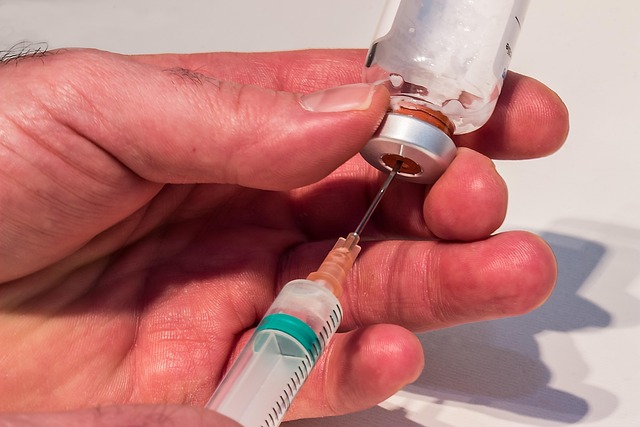Stem cells for bone healing leverage two primary sources: Bone marrow-derived stem cells (BMDSCs) with potent osteogenic capabilities and direct new bone formation benefits, and Adipose-derived stem cells (ASCs), easily harvested from fat tissue, offering robust proliferation, multipotency, and paracrine effects to enhance bone regeneration. Combining their strengths paves the way for advanced therapies in regenerative medicine, leveraging personalized medicine techniques for complex bone defects treatment.
“Explore the dynamic realm of stem cell therapy with a focus on their potential for bone healing. This article delves into the intricate differences between two prominent types: bone marrow-derived and adipose-derived stem cells. We examine their distinct sources, unique properties, and comparative advantages in bone regeneration.
From harvesting techniques to regenerative medicine applications, understand how these cells are revolutionizing bone healing, shaping future treatments for various orthopedic conditions.”
Bone Marrow-Derived Stem Cells: Source and Function
Bone marrow, a rich source of stem cells, plays a pivotal role in our body’s regenerative capabilities. These stem cells, known as bone marrow-derived stem cells (BMDSCs), possess the remarkable ability to differentiate into various specialized cell types. They are particularly valuable for bone healing and regeneration due to their inherent potential to become osteoblasts, the cells responsible for bone formation.
Located within the soft, spongy interior of bones, BMDSCs are easily accessible compared to other stem cell sources. Their close association with the skeletal system makes them highly efficient in repairing and restoring damaged bone tissue. This unique property has garnered significant interest in medical research, particularly for developing innovative treatments aimed at enhancing bone healing and addressing conditions such as osteoporosis or fractures.
Adipose-Derived Stem Cells: Harvesting and Properties
Adipose-derived stem cells, also known as mesenchymal stem cells from adipose tissue, offer a promising avenue for bone healing and regeneration due to their accessibility and robust regenerative capabilities. Harvesting these cells involves a minimally invasive procedure where fat tissue is extracted from patients, typically from areas like the abdominal region or thighs. This simple method provides a rich source of stem cells that can be easily isolated and expanded in vitro.
The properties of adipose-derived stem cells make them ideal for bone-related applications. They possess the ability to differentiate into various cell types, including osteoblasts, which are responsible for bone formation, and chondrocytes, crucial for cartilage repair. These cells also exhibit immunomodulatory properties, suppressing inflammatory responses and promoting a healing environment, making them potential therapeutic agents for treating bone injuries and diseases.
Comparative Advantages for Bone Healing
Bone marrow-derived and adipose-derived stem cells offer distinct advantages in promoting bone healing, each with its unique properties. Bone marrow-extracted stem cells have long been recognized as a gold standard due to their inherent potential for osteogenic differentiation, making them highly effective in regenerating bone tissue. These cells are rich in sources and possess the ability to directly contribute to the formation of new bone, which is crucial for complex fracture repairs and spinal fusion procedures.
Adipose-derived stem cells, on the other hand, provide an attractive alternative due to their abundance in fat tissues, making extraction less invasive compared to bone marrow aspirations. These cells exhibit robust proliferation capabilities and have demonstrated success in enhancing bone regeneration through paracrine effects, where they secrete growth factors that stimulate local stem cell activity and promote angiogenesis, thereby fostering a supportive environment for bone healing.
Applications and Future Perspectives in Regenerative Medicine
Stem cells derived from both bone marrow and adipose tissue have shown immense potential in regenerative medicine, offering novel approaches to various health challenges. The unique properties of each type make them suitable for different applications, especially in bone healing. Bone marrow-derived stem cells (BMSCs) are well-known for their ability to differentiate into multiple cell types, including osteoblasts, making them a promising tool for treating bone fractures and degenerative disorders. Their easy accessibility from peripheral blood provides an advantage for clinical translation. On the other hand, adipose-derived stem cells (ASCs) have gained attention due to their high yield and multipotent potential, capable of differentiating into various cell types like chondrocytes and adipocytes, which is beneficial for treating cartilage injuries and tissue engineering applications.
The future of regenerative medicine lies in combining the strengths of both BMSCs and ASCs. Researchers are exploring ways to manipulate and enhance their capabilities, aiming to develop advanced therapies for complex bone defects and regenerative treatments that mimic natural healing processes. With ongoing advancements in cell isolation, culture, and differentiation techniques, these stem cells offer a promising horizon for personalized medicine, where patients’ own cells can be used to accelerate healing and restore function.
Bone marrow-derived and adipose-derived stem cells offer unique advantages for bone healing, each with distinct properties that cater to specific medical needs. While bone marrow-derived stem cells have been a cornerstone in regenerative medicine, adipose-derived stem cells present a promising alternative due to their abundant availability and potential for enhanced osteogenic differentiation. The comparative advantages discussed highlight the versatility of these cell types in addressing various bone-related disorders. Future research in this field may lead to innovative therapies that utilize stem cells for bone healing, revolutionizing the treatment of traumatic injuries and degenerative conditions.
